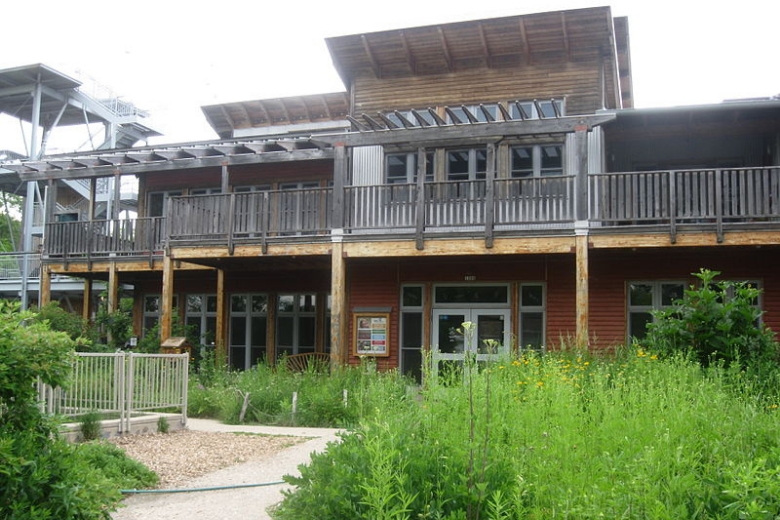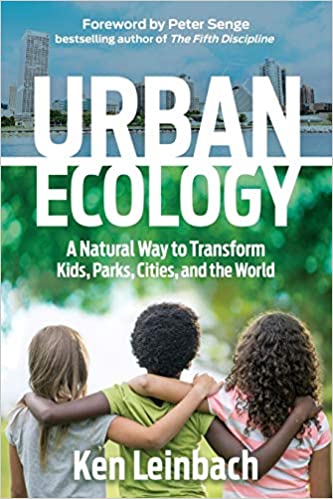
Book Review
Urban Ecology: A Natural Way to Transform Kids, Parks, Cities, and the World
The next time you gather for a campfire, watch to see what happens. You may see friends and strangers pull up chairs, make the circle wider, and slide over a bit to make room for more to join. Notice how each camper begins to relax, smile, and lean closer to the heat and to each other. It won’t be long before stories, songs, and, sometimes, refreshments, are shared. You may find that the embers of the communal experience glow within you long after the good-byes are said and the last log turns to ash.
Throughout Urban Ecology: A Natural Way to Transform Kids, Parks, Cities, and the World (2018), Ken Leinbach, describes how the campfires, both literal and metaphorical, created by the Urban Ecology Center (UEC), bring people together in nature for fun and naturally lead to conversations that bring about profound and lasting impact. Leinbach calls these campfire experiences the UEC’s “Third Way...|LS|or|RS| angled approach to getting where you want to go.”
For more than two decades this “Third Way” approach has resulted in increased ecological literacy, reduced crime, improved academic performance and health, and economic renewal in urban Milwaukee.
Urban Ecology is the story of how the UEC operations and programming began in a double-wide trailer at Riverside Park, Milwaukee, to expand to three elegant LEED-certified Urban Ecology Centers annually serving more than 60 schools and 200,000 children, families, and adults of all ages. Reflecting on the success of the UEC, Leinbach offers a replicable system for “someone... who simply wants to make a difference in their own neighborhood.”
Written primarily as a first-person narrative, the author takes the reader on a journey of environmental and community transformation. This journey very intentionally crosses racial and socio-economic divides in the neighborhoods where centers are located. Along the way, Leinbach introduces us to staff, volunteers, community members, students, and funders, who have been brought together because of the UEC’s Third Way approach.
Each chapter of Urban Ecology offers readers inspirational stories, explicit advice and resources in a “Let’s Get Practical” section. Photos, maps, anecdotes, and poems illustrate the lessons learned through the UEC approach and enhance the reading experience. Readers will find the extensive list of recommended books, websites, and organizations included in the “Afterword--The Sacred” to be helpful. However, those interested in reading the research articles referenced by Leinbach will be frustrated to find that a bibliography is absent.
Throughout the text, the reader is encouraged to visit the supplementary website urbanecologycenter.org/book for PDF files of “Our Decision Making Lenses,” and “Pie Charts for Funding and Expenditures,” as well as other resources both shared and alluded to in the Urban Ecology. Currently, only three documents and the Ecology Center’s blog are linked with the promise of more to come. While the black and white photos within each chapter help to document the Urban Ecology Center’s history and success, low-resolution digital photos and scanned snapshots, when printed on uncoated paper, resulted in poor quality images in many instances.
Read individually, or as part of a book study, Urban Ecology is a compelling text for anyone with hope for healthy people and the planet.
Educators or conservation-minded individuals will identify with the lessons of stewardship and habitat restoration projects. The author shares stories of the transformation of contaminated land and polluted waterways at each of the three UEC locations in “Chapter 8: Healing.” Readers will learn how hundreds of volunteers, sometimes entire teams from local businesses, worked to make these spaces safe for not only people, but for wildlife as well. As habitat improvements are made, species not seen in decades, including the Butler’s garter snake, are documented by citizen scientists and wildlife biologists.
With chapters focused on topics such as defining the organization or program, decision-making, leadership, finances, and human resources, organizational and program leaders will learn about sustainable methods of meeting their missions. Organizational leaders and board members will find “Chapter 6: Urban Ecology Center Defined” particularly useful. The author shares how the UEC is defined by finances, through an 80%/20% model for funding. That is, 80% of the funding comes from grants, donations, and fundraising events, and the other 20% comes from program fees. By specifically defining finances with a funding model--it doesn’t need to be an 80%/20%, but one that makes sense--an organization is in a better position to allocate time and talent to meet these goals. In this same chapter, Leinbach describes how the UEC is defined by “Twelve Crucial Elements,” each created to meet the objective of repeat visitation by community members. Organizational leaders can see how having a similar list of non-negotiables can help to not only define an organization, but to also guide services, spending and other decisions toward realizing its mission.
Urban Ecology: A Natural Way to Transform Kids, Parks, Cities, and the World is an invitation to gather around the campfire to grow in our community connection with nature where we live. S’mores, anyone?
Sandy Benton
FIELD Edventures co-founder and coach
Sandy is passionate about teaching and learning. Her experiences as both an instructional coach and a classroom teacher indicate that deep, lasting learning occurs when instruction is interdisciplinary, hands-on, and grounded in real world experiences.
References
Leinbach, Ken. Urban ecology: A natural way to transform kids, parks, cities, and the world. New York, Morgan James Publishing, 2018.
Disclosure: Please note that we may use affiliate links to retailers which yield a commission for us at no extra cost to you. We only recommend products we've used that support our mission. As an Amazon Associate FIELD Edventures earns from qualifying purchases. Your purchases support taking learning outdoors.

